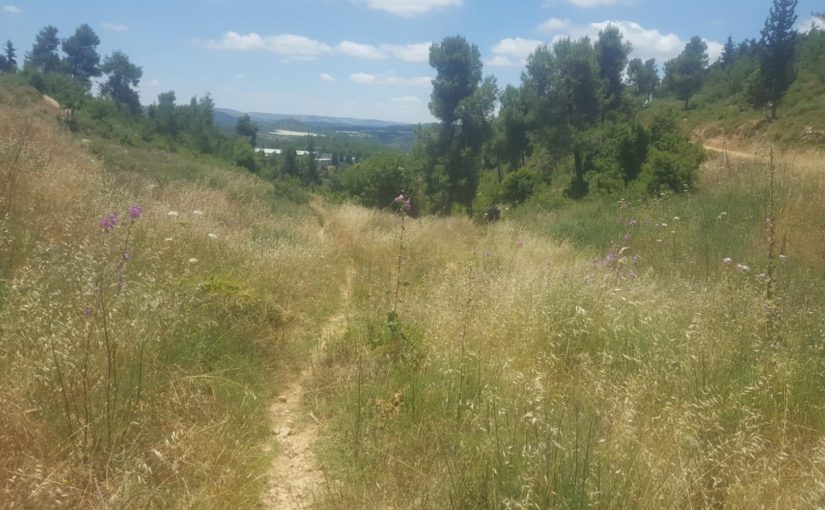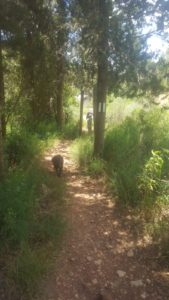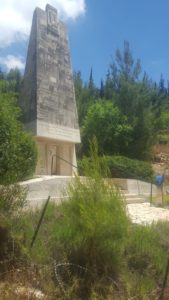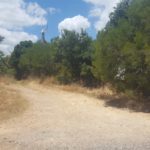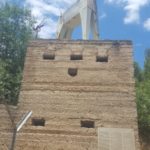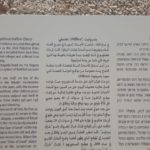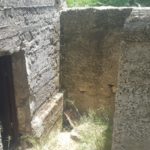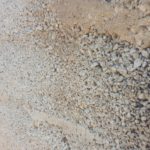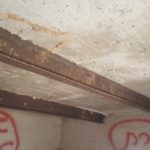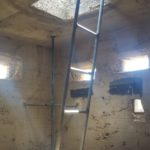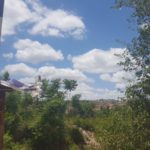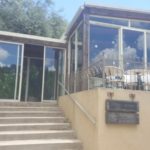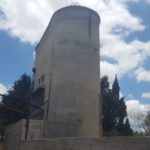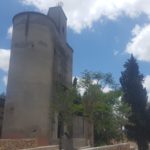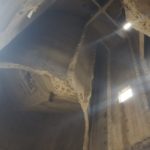Hi,
Today we decided to walk the all 1948 trail (Tashach trail in Hebrew, the Hebrew year Independence war), going down from Har Adar to Kibbutz Kiryat Anavim cemetery (Judean mountains area).
We had some walks with the kids down to the Santorum Post post or to #2 Santurom post, but never all the way down to the military cemetery of Kiryat Anavim (I used to run this trail for some years).
The trail is through pine tree forest that was planted during the 1930s, and pretty much tell the story of the fights of Independence war around Jerusalem: the fights on Har Adar (The Radar mountain) and the posts around it, to the cemetery were most of the fighters and soldiers from this war in this area are buried.
Take Care
Gad
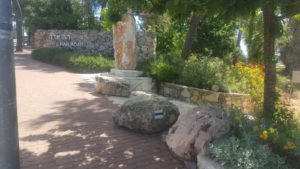 The upper entrance to the 1948 trail
The upper entrance to the 1948 trail
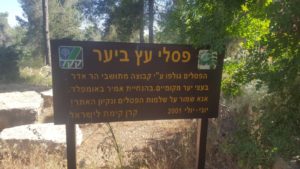 On the first couple of hundred meter of the trail standing a beautiful timber statues made by a group of Har Adar people on June-July 2001.
On the first couple of hundred meter of the trail standing a beautiful timber statues made by a group of Har Adar people on June-July 2001.
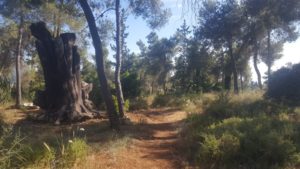 One of the timber statues on the trail.
One of the timber statues on the trail.
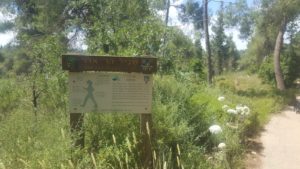 Har Adar trail along the road to the settlement, part of it is parallel to 1948 trail.
Har Adar trail along the road to the settlement, part of it is parallel to 1948 trail.
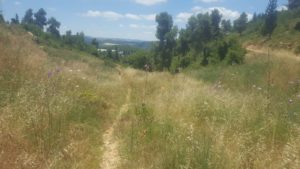 The second part of 1948 trail going down to the creek on which Kiryat Anavim cemetery is sitting.
The second part of 1948 trail going down to the creek on which Kiryat Anavim cemetery is sitting.
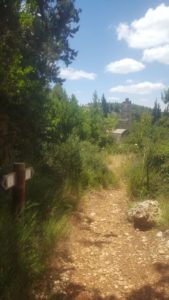 The building is the hall of fallen of Harel Brigade from the Palmach that thought in this area.
The building is the hall of fallen of Harel Brigade from the Palmach that thought in this area.
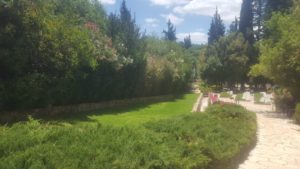 Kiryat Anavim cemetery – designed as all other military cemetery but unique
Kiryat Anavim cemetery – designed as all other military cemetery but unique
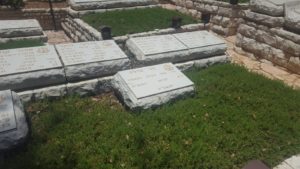 Benny Berale grave. The IDF fallen soldiers graves, marks the name, birthplace and date, the parents names, age and place of death. Benny Berale marks only name and place of death. Like many, he was an Holocaust survivor immigrated to Israel and fought in the Independence war. Except his name none is known about him, not even a picture, as you can read in the blog BennyBerale trying to find out who he was.
Benny Berale grave. The IDF fallen soldiers graves, marks the name, birthplace and date, the parents names, age and place of death. Benny Berale marks only name and place of death. Like many, he was an Holocaust survivor immigrated to Israel and fought in the Independence war. Except his name none is known about him, not even a picture, as you can read in the blog BennyBerale trying to find out who he was.
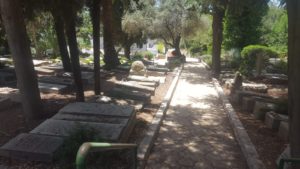 The civil cemetery of Kiryat Anavim. The two part are merged, as the graves in the military part were dug in an hurry and without design during the Independence war.
The civil cemetery of Kiryat Anavim. The two part are merged, as the graves in the military part were dug in an hurry and without design during the Independence war.
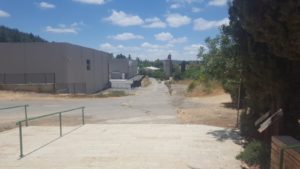 Looking out from the cemetery over the silo (hosting a bakery now days) and the chicken coops (used as building supply store)
Looking out from the cemetery over the silo (hosting a bakery now days) and the chicken coops (used as building supply store)
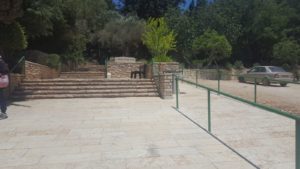 The entrance to military cemetery
The entrance to military cemetery
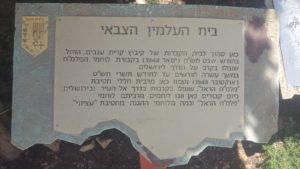 One of 3 sign on the entrance to the cemetery: “The military cemetery – Here, near Kibbutz Kiryat Anavim cemetery, the burial of Palmach fighters who fall on the war on the way to Jerusalem has started on January 1948.
One of 3 sign on the entrance to the cemetery: “The military cemetery – Here, near Kibbutz Kiryat Anavim cemetery, the burial of Palmach fighters who fall on the war on the way to Jerusalem has started on January 1948.
Until October 1948, most of the fallen of the Harel brigade of the War on the road to Jerusalem were buried here. Today there are 138 graves, most of Harel Brigade, the rest of Etzioni Brigade“
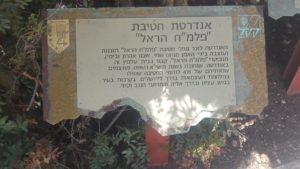 Second of 3 signs: The Harel brigade of the Palmach memorial – the hall of fallen was designed by the artist Menahem Shemi, which his son, Aharon (Jimi) which was a commanders in the brigade, is burried in this cemetary. The memorial, opened in 1951, holds the names of 418 of the brigade fallen from the war on the road to Jerusalem, in Jerusalem, In Gush Etzion, The Negev and Sinai.”
Second of 3 signs: The Harel brigade of the Palmach memorial – the hall of fallen was designed by the artist Menahem Shemi, which his son, Aharon (Jimi) which was a commanders in the brigade, is burried in this cemetary. The memorial, opened in 1951, holds the names of 418 of the brigade fallen from the war on the road to Jerusalem, in Jerusalem, In Gush Etzion, The Negev and Sinai.”
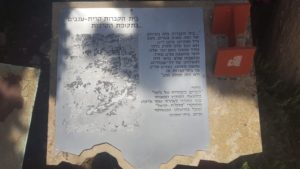 Third sign out of 3: “Kiryat Anavim cemetery during the war: ‘the cemetery was only couple of hundred steps, and grow wider every day. He became part of our everyday routine. Our thoughts, never to be spoken, were wandering from us, the living, over to this cemetery. And you could not escape those.” Friends talking on Jimi, a memorial to Aharon (Jimi) Shemi, one of Harel brigade of the Palmach, who fell on Beit – Shemesh.
Third sign out of 3: “Kiryat Anavim cemetery during the war: ‘the cemetery was only couple of hundred steps, and grow wider every day. He became part of our everyday routine. Our thoughts, never to be spoken, were wandering from us, the living, over to this cemetery. And you could not escape those.” Friends talking on Jimi, a memorial to Aharon (Jimi) Shemi, one of Harel brigade of the Palmach, who fell on Beit – Shemesh.
‘The Bitzronit HaTzvi (Deer Pillbox)
In 1929 events of violence occurred throughout the land, known as the 1929 Palestine Riots. Kiryat Anavim was a secluded town back then, surrounded by Arab villages and suffered from strategical inferiority.
In order to meet tragedy head on, the Hagana organization built a system of fortified outposts for guarding.
The first outpost was built on top of the sanatorium, where the Maale Ha-Hamisha hotel is today. Over the years, with the increase in incidents of bloodshed, other defense posts were built. This concrete outpost was built in the 1940s and it was three stories tall and had places for watching and shooting.
About half a kilometer north of her, further up the hill, is a sanatorium outpost #2 where in May 1948 Yisrael (Zusia) Shapira, a member of Kiryat Anavim was killed. In the 1970s his family placed a deer statue called “the Deer of Israel” at the top of the outpost. The statue became old and after it was renovated it was moved here, Where the statue used to be, a new “Deer of Israel” statue was placed in 2010 at the sanatorium #2 outpost.”
The silo and the building next to it, now house Efrat bakery

